Posted by James (admin) on 20th May 2014
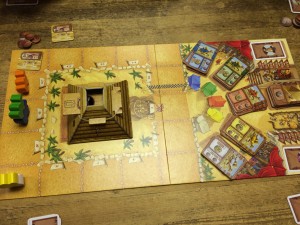 Camel Up is a simple game so it is surprising how much interaction there is and how lively it can be. During the game, camels move around a simple circuit; however, players do not own a specific camel as you may expect. Instead, players take actions which can move the camels as well as try to predict which camel will win the current round, as well as the overall race. The winner is the player with the most money (Egyptian Pounds, or EPs) at the end of the game.
Camel Up is a simple game so it is surprising how much interaction there is and how lively it can be. During the game, camels move around a simple circuit; however, players do not own a specific camel as you may expect. Instead, players take actions which can move the camels as well as try to predict which camel will win the current round, as well as the overall race. The winner is the player with the most money (Egyptian Pounds, or EPs) at the end of the game.
Players take turns by performing one of 4 actions which are:
1. Move a camel
The player drops 1 dice out of the pyramid and moves the matching coloured camel that number of spaces forwards along the track. (There are 5 dice – one for each camel each with values 1 to 3 – more about the pyramid later.) If camels are moved to space occupied by camels they are stacked on top of those already there. When camels move, they carry any other camels already on top of them along with them too. This action earns the player 1 EP. (The dice only get placed back in the pyramid after all 5 have come out which and this ends the round.)
2. Place/Move their desert tile on the race track
This tile earns 1 EP for its owner each time a camel lands on it, plus it moves that camel forwards 1 space if the tile is oasis side-up, or backwards 1 space if the tile is mirage side-up. Read the rest of this entry »
Tags: board game news, Board Games, board gaming, Camel Up, Eggertspiele, Pegasus Spiele, SdJ, Spiel des Jahres
Posted in Board Game Review, Board Games, Camel Up | 2 Comments »
Posted by James (admin) on 17th April 2014
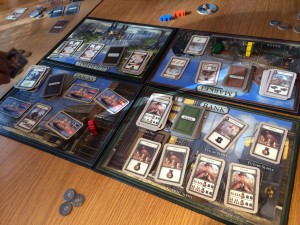 One of my favourite board games ever is Oregon (which was the game the designers of Rattus made before Rattus). So, after many Rattus expansions, I was very excited when the Bergs announced a new, original game called Packet Row with a very interesting game mechanic.
One of my favourite board games ever is Oregon (which was the game the designers of Rattus made before Rattus). So, after many Rattus expansions, I was very excited when the Bergs announced a new, original game called Packet Row with a very interesting game mechanic.
The game is set in New York in 1842 and players are trading companies. The game board is comprised of 4 boards (Docks, Bank, Market and Guildhall) where the cards for each board are displayed. The primary method of earning money is by completing contracts (Guildhall cards) which can be fulfilled by having the goods (Market cards) and ship (Dock cards) shown on the contract. Money can also be gained from the bank (Bank cards), plus various other cards in all areas have some special effects too including some being worth victory points (VPs). At the end of the game, players add up their VPs from cards that show VPs, cash (divided by 10), and banker cards (if they have the most cash) – most VPs wins. This means cash is vital because most cards cost money, and cards can earn you more money, VPs and special abilities.
Gameplay is simple and fast as each player may gain up to 1 card during a round. So far this is all straight forwards but it is how the cards are gained that is the interesting heart of Packet Row. Each round, one player is the lead player (the harbour master) and they select one of the 4 boards. All players then take turns choosing to either take one of the cards from this board or pass. The harbour master is the last player to choose – if the harbor master takes a card then the round ends and any player(s) who passed get nothing. If the harbour master doesn’t take a card, then the harbour master chooses another board and all players who have not yet taken a card this round have the same choice again – take a card from this board or pass. Read the rest of this entry »
Tags: board game news, Board Games, board gaming, Essen, Oregon, Packet Row, Rattus, Spiel 13, Spiel 2013, White Goblin Games
Posted in Board Game Review, Board Games, Essen Spiel 13, Packet Row, Spiel 2013 | No Comments »
Posted by James (admin) on 16th April 2014
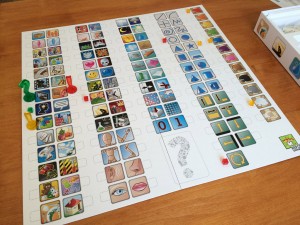
My attempt at ‘Wheel of Fortune’ using TV show with ideas as the main concept. Then, adding a sub-concept of Title with circle, rotate & cash. Then, adding a sub-concept of Country with Red, White, Blue & Star. Anyone? Anyone? Bueller?
Concept is a party game that is a bit like charades without the acting and players use a board with icons to convey the various concepts so the other players can guess the correct answer. Each turn, the players whose turn it is draw a card and choose which word/expression they will try to convey by placing coloured markers on the different descriptive icons on the board. Player aid sheets show all the icons with 2 or 3 things that each icon could mean (although players can use them to mean anything they want). Icons show things like colours, shapes, parts of the body, etc. and some have broader potential meaning like a figure with a walking stick can mean Old/Ancient/Past.
To convey a word/phrase, the current players place various markers on these icons. There is one green question mark marker with green cubes (which is used to describe the main concept) and 4 different colour exclamation mark markers with matching coloured cubes (which can be used to describe additional sub-concepts).
For example, to convey ‘Eiffel Tower’ a player could place the green question mark on ‘Object/Thing/Package’ and a green cube on ‘Tall/Greater/High’ to try to convey the main concept is a tall object. Then, they place a red exclamation mark on ‘Location/Country/Flag’ and red cubes on ‘Red’, ‘White’, and ‘Blue’ to convey the sub-concept is a country with a red, white and blue flag. Already the description is taking shape, although players may guess it’s The Shard in London, or the World Trade Centre in New York from the same markers. Read the rest of this entry »
Tags: board game news, Board Games, board gaming, Concept, Essen, Repos Productions, Spiel 13, Spiel 2013
Posted in Board Game Review, Board Games, Concept, Essen Spiel 13, Spiel 2013 | No Comments »
Posted by James (admin) on 15th April 2014
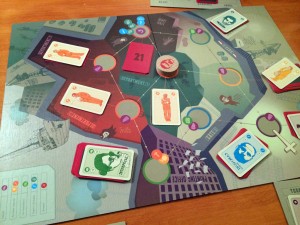 Strike is a game about Lech Wałęsa – a Polish electrician who became a trade-union activist, co-founded Solidarity (the Soviet bloc’s first independent trade union) and eventually went on to become President of Poland. The game focuses on the Polish strikes of 1980 and the agreement reached between the workers and the government. (Yes, really.)
Strike is a game about Lech Wałęsa – a Polish electrician who became a trade-union activist, co-founded Solidarity (the Soviet bloc’s first independent trade union) and eventually went on to become President of Poland. The game focuses on the Polish strikes of 1980 and the agreement reached between the workers and the government. (Yes, really.)
This theme may sound unusual even compared to some other board games, but the historical Polish theme is more understandable when you know the game is by Karol Madaj the designer of Kolejka (Queue) – one of my favourite games ever – who designs games for Poland’s Institute of National Remembrance. One of their goals is to mark important moments in Polish history.
Theme-aside, Strajk is fundamentally a deck-building game mechanic but with a board and a bit if a difference too. (If you’re not familiar with deck-building games such as Dominion, players each have their own deck and play cards to add better cards to their deck, take special actions, remove weaker cards from their deck, etc. Whenever their deck is empty, they shuffle their discard pile and start drawing from it again so their deck builds as they play.) Read the rest of this entry »
Tags: board game news, Board Games, board gaming, Essen, Kolejka, Queue, Reglamentacja, Spiel 13, Spiel 2013, Strajk, Strike
Posted in Board Game Review, Board Games, Essen Spiel 13, Kolejka (Queue), Reglamentacja, Spiel 2013, Strajk (Strike) | No Comments »
Posted by James (admin) on 14th April 2014
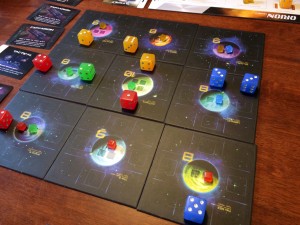
Quantum is a light, space-themed game. Players have ships which are represented by dice that travel between the planets trying to colonise them (place cubes on them). The first player to place all their cubes wins.
The ships (dice) are rolled to determine what type of ship they are – a low number means they are slow moving but powerful in combat, and vice versa. (In fact, the dice value is how many spaces they can move which makes things simple.) Each type of ship has a special power too, such as transporting another ship, swapping places, changing a ship’s value and this makes each quite different.
On their turn, a player can take 3 actions. An action can be used to activate a ship (move/attack), re-roll a ship, bring a ship on from the scrap yard, or carry out research. A player can use 2 actions to place a cube on a planet if they have ships next to the planet that add up to the planet’s number and if there is still room to place a cube there. (A player can also place a cube if they win enough combats.) Read the rest of this entry »
Tags: board game news, Board Games, board gaming, Essen, Funforge, Quantum, Spiel 13, Spiel 2013
Posted in Board Game Review, Board Games, Essen Spiel 13, Quantum, Spiel 2013 | No Comments »
Posted by James (admin) on 11th April 2014
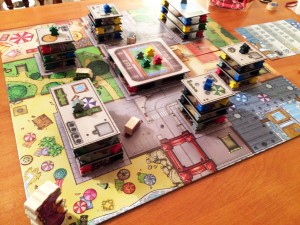 Rampage is a brilliant concept for a dexterity game. It’s like a Godzilla-style movie with tall buildings to destroy and people to eat. The board is divided into several coloured areas called neighbourhoods, and the player with the most Victory Points (VPs) at game end wins.
Rampage is a brilliant concept for a dexterity game. It’s like a Godzilla-style movie with tall buildings to destroy and people to eat. The board is divided into several coloured areas called neighbourhoods, and the player with the most Victory Points (VPs) at game end wins.
Rampage may sound kind of normal so far for a board game but it is anything but that as the gameplay is actually based on physically destroying the city. Each turn, your monster get 2 actions. To move your monster, you flick the feet disc. To attack buildings, take your monster piece and drop it onto a building (if you’re near enough). To use your breathe attack, place your chin on your monster piece and blow. To throw a vehicle, place the vehicle piece on top of your monster and flick it. Monsters can attack anything including each other and a successful attack removes one of their teeth. After their actions, your monster eats meeple out in the open in their current neighbourhood but no more than the number of teeth they have.
Buildings consist of layers of card floors separated by meeple of random colours. You want to knock these buildings down so you can (potentially) eat the meeple but you also take any floor sections which have nothing on them as these are worth VPs too. Read the rest of this entry »
Tags: board game news, Board Games, board gaming, Essen, Rampage, Repos Productions, Spiel 13, Spiel 2013
Posted in Board Game Review, Board Games, Essen Spiel 13, Rampage, Spiel 2013 | No Comments »
Posted by James (admin) on 10th April 2014
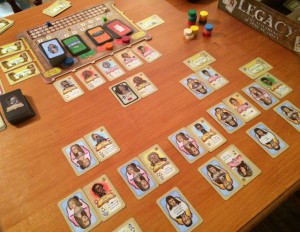
Legacy (or Legacy: Testament of Duke de Crecy to give it its full name) is a very innovative game where players try to create the most successful 18th century family starting with a single family member. Each round, players use their actions so that the current generation can get married, have children, buy mansions, start business ventures, arrange marriages for their children, etc. After a fixed number of rounds, the children grow up, any arranged marriages take place, and they become the current generation. Players then use actions for this new generation to get married, have children, etc. After the 3rd generation’s actions, the game ends and the player with the most points (Honour) wins.
Each player has an income track which earns cash each round, and a prestige track which earns Honour each generation. Players also earn Honour for having children, fulfilling objectives on their Patron card, fulfilling missions, as well as from friends marrying into the family, acquiring titles, etc. Plus, players must constantly manage their cash and friends – Friends are cards in a player’s hand each showing their sex, nationality, occupation, benefit when married into your family, and marriage cost (some generate cash as they come with a dowry). Read the rest of this entry »
Tags: board game news, Board Games, board gaming, Essen, Legacy, Portal Publishing, Spiel 13, Spiel 2013
Posted in Board Game Review, Board Games, Essen Spiel 13, Legacy, Spiel 2013 | 4 Comments »
Posted by James (admin) on 9th April 2014
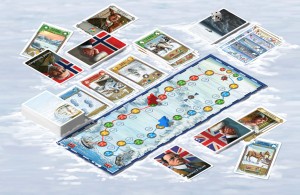 1911 Amundsen vs Scott is a simple, quick-moving, 2-player race to the South Pole which is full of small decisions. The game is based on the real events where Amundsen beat Scott to the Pole and Scott didn’t return.
1911 Amundsen vs Scott is a simple, quick-moving, 2-player race to the South Pole which is full of small decisions. The game is based on the real events where Amundsen beat Scott to the Pole and Scott didn’t return.
Players each have their own path of coloured spaces to move along and the first player to reach the South Pole wins. On their turn, a player draws 1-3 cards and can then play cards. When taking cards, you must draw the right-most (oldest) 1, 2 or 3 cards by discarding 0, 1 or 3 cards from your hand respectively. This can make for some interesting decisions because if you see cards you really want (or ones you don’t to deny your opponent) then you must decide whether it’s worth discarding cards you have to gain the new ones.
Almost all cards show one of 4 colours and many cards show one of the various special actions too (occurring when drawn, played or discarded). To move, you must play cards that match the colours of the next spaces along your path – 1 card for your next space, 2 cards for each space after that. This adds lots of fast card-management decisions to your game as you’re constantly trying to collect the mix of cards that will advance you and hinder your opponent. Many cards are both a colour and a type which adds some extra decisions to work out whether to use a card for its colour or its type (special effect). This is made slightly more tricky because you have a hand limit of 7 cards (and sometimes even fewer), plus the mix of cards you want changes rapidly as you and your opponent move. Read the rest of this entry »
Tags: 1911 Amundsen vs Scott, board game news, Board Games, board gaming, Essen, Spiel 13, Spiel 2013
Posted in 1911 Amundsen vs Scott, Board Game Review, Board Games, Essen Spiel 13, Spiel 2013 | No Comments »
Posted by James (admin) on 8th April 2014
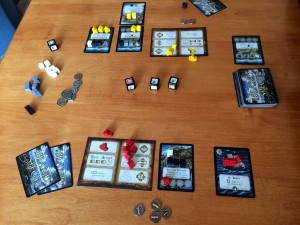 Island Siege caught my interest when it was a Kickstarter project but I only picked it up recently. A game for 2-players, it’s a card game at heart but feels bigger because the cards played stay on the table (well, until they’re blown to smithereens) and there are some very nice metal coins, a few wooden meeple and some dice too.
Island Siege caught my interest when it was a Kickstarter project but I only picked it up recently. A game for 2-players, it’s a card game at heart but feels bigger because the cards played stay on the table (well, until they’re blown to smithereens) and there are some very nice metal coins, a few wooden meeple and some dice too.
A player wins at the very start of their turn if all of the colonists on their Imperial card have been placed elsewhere or if they have 20+ coins. Each player starts with a fortress, a few cards in hand, and 9 colonists (meeple) on their Imperial card. Each turn, a player moves 1 colonist from their Imperial card onto each of their fortresses and then either:
- Draws 3 cards, keeping 2 and giving the other to their opponent
- Pays the relevant cost to build a card (fortress, ship or building) from their hand
- Attacks one of their opponent’s fortresses
Fortresses can be built for free, but adding extra building blocks (black/grey/white cubes) from your supply makes them stronger and earns coins. Buildings and ships can be built by moving enough colonists from a single fortress card to the building/ship card and this also earn coins. Buildings are added to a fortress giving it special abilities, but buildings are lost if the fortress they’re attached to is destroyed. Ships are independent, have special abilities and can also be destroyed.
Read the rest of this entry »
Tags: Ape Games, board game news, Board Games, board gaming, Island Siege
Posted in Board Game Review, Board Games, Island Siege | No Comments »
Posted by James (admin) on 7th February 2014
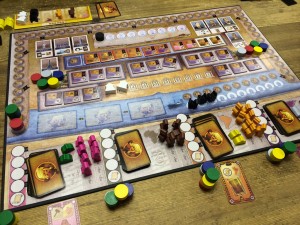 Artifact is a worker placement game with a difference as players place a common set of action markers which are limited in number and the cost of using them varies.
Artifact is a worker placement game with a difference as players place a common set of action markers which are limited in number and the cost of using them varies.
THE GAME
Players are archaeologists digging up artifacts, shipping them home and putting on exhibitions (after all, as Indy taught us, ‘they belong in a museum’). Players primarily score victory points (VPs) at game end by gaining museum exhibition tiles and having cash. The final round is triggered by one of 4 different events such as finishing the 8th round, when one deck of artifact cards runs out, etc.
Actions
During a round, players take turns performing either 1 or 2 actions. If a player passes, they can not perform any more normal actions that round (although they can perform a special action on their turn). All players start each round with 6 wooden action markers and there are 6 different types of these: ships, museums and 4 different colours of workers (one for each continent). The board has a track for each type of action marker and each space on these tracks shows a cost (going from from 5 down 1). Read the rest of this entry »
Tags: Artifact, Bernd Eisenstein, board game news, Board Games, board gaming, Essen, Jeffrey D Allers, Spiel 13, Spiel 2013, White Goblin Games
Posted in Artifact, Board Game Review, Board Games, Essen Spiel 13, Spiel 2013 | No Comments »
 Camel Up is a simple game so it is surprising how much interaction there is and how lively it can be. During the game, camels move around a simple circuit; however, players do not own a specific camel as you may expect. Instead, players take actions which can move the camels as well as try to predict which camel will win the current round, as well as the overall race. The winner is the player with the most money (Egyptian Pounds, or EPs) at the end of the game.
Camel Up is a simple game so it is surprising how much interaction there is and how lively it can be. During the game, camels move around a simple circuit; however, players do not own a specific camel as you may expect. Instead, players take actions which can move the camels as well as try to predict which camel will win the current round, as well as the overall race. The winner is the player with the most money (Egyptian Pounds, or EPs) at the end of the game.



 Strike is a game about Lech Wałęsa – a Polish electrician who became a trade-union activist, co-founded Solidarity (the Soviet bloc’s first independent trade union) and eventually went on to become President of Poland. The game focuses on the Polish strikes of 1980 and the agreement reached between the workers and the government. (Yes, really.)
Strike is a game about Lech Wałęsa – a Polish electrician who became a trade-union activist, co-founded Solidarity (the Soviet bloc’s first independent trade union) and eventually went on to become President of Poland. The game focuses on the Polish strikes of 1980 and the agreement reached between the workers and the government. (Yes, really.)




